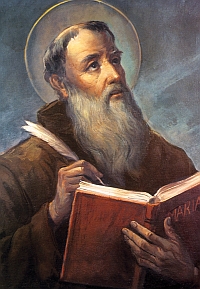Lawrence of Brindisi facts for kids
Quick facts for kids SaintLawrence of Brindisi O.F.M. Cap. |
|
|---|---|
 |
|
| Priest; Doctor of the Church | |
| Born | 22 July 1559 Brindisi, Kingdom of Naples |
| Died | 22 July 1619 (aged 60) Lisbon, Portugal |
| Venerated in | Roman Catholic Church |
| Beatified | 1 June 1783, Saint Peter's Basilica, Papal States by Pope Pius VI |
| Canonized | 8 December 1881, Saint Peter's Basilica, Kingdom of Italy by Pope Leo XIII |
| Major shrine | Villafranca del Bierzo |
| Feast | 21 July |
| Attributes |
|
| Patronage | Brindisi |
Lawrence of Brindisi (born Giulio Cesare Russo; 22 July 1559 – 22 July 1619) was an important Roman Catholic priest and a deep thinker (a theologian). He was also a member of the Order of Friars Minor Capuchin, a group of Franciscan friars.
Lawrence was very good with languages. Besides his native Italian, he could speak and read Latin, Hebrew, Greek, German, Bohemian, Spanish, and French fluently. He became a priest when he was 23 years old. Later, he was recognized as a saint. He was beatified on June 1, 1783, and officially made a saint on December 8, 1881.
Contents
Biography
Early Life and Education
Giulio Cesare Russo was born in Brindisi, which was part of the Kingdom of Naples at the time. His family were merchants from Venice. Sadly, his parents died when he was young. His uncle then raised him, and he went to school at Saint Mark's College in Venice.
Later, Cesare joined the Capuchin friars in Verona. He became known as Brother Lawrence. He continued his studies at the University of Padua. He was known for his amazing language skills, being able to speak many languages fluently. He became a priest at the age of 23.
Church Leadership and Missions
When Lawrence was 31, he was chosen to lead the Capuchin Franciscan group in Tuscany. In 1596, he was appointed as a general advisor for the Capuchins in Rome. Pope Clement VIII gave him the special job of preaching to the Jewish community in the city. He was so good at Hebrew that some rabbis thought he had once been Jewish himself.
Starting in 1599, Lawrence helped set up new Capuchin monasteries in what are now Germany and Austria. He played a big part in the Counter-Reformation. This was a time when the Catholic Church worked to bring people back to the Catholic faith, especially those who had become Protestants.
Military Role and Diplomacy
In 1601, Lawrence served as a chaplain (a religious leader for soldiers) for the army of Rudolf II, Holy Roman Emperor. He successfully convinced Philippe Emmanuel, Duke of Mercœur to help fight against the Ottoman Turks. Lawrence even led the army during the siege of Székesfehérvár in Hungary. He went into battle armed only with a crucifix.
In 1602, he was chosen as the vicar general of the Capuchin friars. This was the highest position in their Order at that time. He was chosen again in 1605 but decided not to take the job. He then worked for the Holy See (the Pope's government), becoming a papal nuncio (a Pope's ambassador) to Bavaria.
Later Life and Death
After serving as a papal nuncio in Spain, Lawrence decided to retire to a monastery in 1618. However, he was called back in 1619 for an important mission. He was sent as a special envoy (a messenger or diplomat) to the King of Spain. His task was to discuss the actions of the Viceroy of Naples.
After completing his mission, Lawrence died on his birthday in Lisbon, Portugal. He was buried at the Poor Clares' Convento de la Anunciada (Convent of the Annunciation) in Villafranca del Bierzo, Spain.
Veneration
Lawrence of Brindisi was recognized for his holy life. He was beatified (declared blessed) in 1783 by Pope Pius VI. Later, he was canonized (declared a saint) in 1881 by Pope Leo XIII.
Works
Saint Lawrence of Brindisi wrote many books and sermons during his life. His complete works were published in 15 volumes between 1926 and 1956. These writings include:
- Mariale (writings about the Virgin Mary)
- Lutheranismi hypotyposis (a work discussing Protestantism)
- Explanatio in Genesim (an explanation of the Book of Genesis from the Bible)
- Quadragesimale primum (first collection of Lenten sermons)
- Quadragesimale secundum (second collection of Lenten sermons)
- Quadragesimale tertium (third collection of Lenten sermons)
- Quadragesimale quartum (fourth collection of Lenten sermons)
- Adventus (sermons for Advent)
- Dominicalia (sermons for Sundays)
- Sanctorale (sermons about saints)
- Sermones de tempore (sermons for specific times of the year)
His original handwritten books fill 13 volumes made of parchment. They are kept safe at the Archivio dei Cappuccini di Mestre.
See also
 In Spanish: Lorenzo de Brindis para niños
In Spanish: Lorenzo de Brindis para niños

